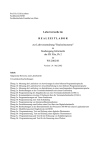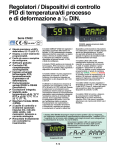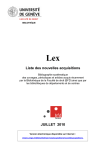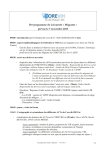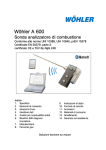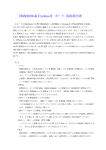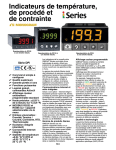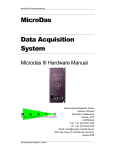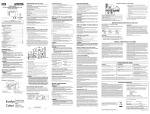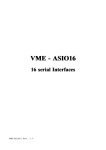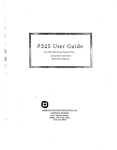Download VME - DPIO32 - esd electronics, Inc.
Transcript
VME - DPIO32 32 digital Inputs or Outputs Hardware Manual VME-DPIO32 Hardware Manual Rev. 2.1 N O T E The information in this document has been carefully checked and is believed to be entirely reliable. esd makes no warranty of any kind with regard to the material in this document, and assumes no responsibility for any errors that may appear in this document. esd reserves the right to make changes without notice to this, or any of its products, to improve reliability, performance or design. esd assumes no responsibility for the use of any circuitry other than circuitry which is part of a product of esd gmbh. esd does not convey to the purchaser of the product described herein any license under the patent rights of esd gmbh nor the rights of others. esd electronic system design gmbh Vahrenwalder Str. 205 D-30165 Hannover Germany Phone: +49-511-372980 FAX: +49-511-633650 This document shall not be duplicated, nor its contents used for any purpose, unless express permission has been granted. Copyright by esd VME-DPIO32 Hardware Manual Rev. 2.1 Manual File: i:\texte\doku\manuals\vme\dpio32\dpio21h.eng Described PCB version 29.07.97 DPI32-5 S/N AB043 and later Changes in the chapters The changes in the user’s manual listed below affect changes in the firmware, as well as changes in the description of the facts only. Chapter 2. Change Chapter ’Software’ now a separate document. Further technical changes are subject to change without notice. VME-DPIO32 Hardware Manual Rev. 2.1 VME-DPIO32 Hardware Manual Rev. 2.1 User’s Manual DPIO32 Content Page 1. Hardware . . . . . . . . . . . . . . . . . . . . . . . . . . 1.1 Overview . . . . . . . . . . . . 1.1.1 Board Description . . . . 1.1.2 Summary of Technical Data 1.1.3 Software Support . . . . . . . . 3 3 5 8 . . . . . . . . . . . . . . . . . . 9 1.3 Address Covering of VME-DPIO32 . . . . . . . . . . . . 11 1.4 Jumpers Configuration . . . . . . . . . . . . . 1.4.1 Default Setting . . . . . . . . . . . . . 1.4.2 The Address-Modifier AM Jumper J3 . . . . 1.4.3 Basic Address Decoding via the Jumpers J1 J2 . . . . . . . . . . . . . . . . . . . . . . . 13 14 15 . 19 1.5 Interrupt Processing . . . . . . . . . . . . . . . . . 21 1.6 The Digital Inputs and Outputs . . . . . . . . . . 1.6.1 Controller Assignment to Inputs and Outputs 1.6.2 Pulse Processor HD63143 Structure . . . . . 1.6.3 Input and Output Circuit of DPIO32 . . . . 1.6.3.1 General . . . . . . . . . . . . . . 1.6.3.2 Front Panel LEDs and Test Sockets . 1.6.3.3 Input and Output Circuit Diagram . . . . . . . . . 23 23 25 27 27 29 30 2. Appendix . . . . . . . . . . . . . . . . . . . . . . . . . . 31 2.1 Connector Pin Assigments . . . . . . . . . . . . . . . 2.1.1 VMEbus P1 . . . . . . . . . . . . . . . . . . . 2.1.2 I/O Connector P2 . . . . . . . . . . . . . . . 2.1.3 Terminal Block I/O Connector P2 Phönix FLKM64 or FLKMS64 . . . . . . . . . . . . . . . . . . . 2.1.4 Description of the Signals at the I/O Connector P2 (or Terminal Block) . . . . . . . . . . . . . 2.1.5 Wiring Diagrams . . . . . . . . . . . . . . . . 31 31 32 33 . . . . . . . . . . . . . . . . . . . . . 39 2.3 Circuit Diagrams . . . . . . . . . . . . . . . . . . . 41 . . . . . . . . . . . . . . . . . . . . . 43 1.2 Order Information 2.2 Front Panel 2.4 Data Sheets VME-DPIO32 Hardware Manual Rev. 2.1 . . . . . . . . . . . . . . . . . . . . . . . . . . . . . . . . . . . . . . . . 3 . . . . . . and . . . . . . . . . 34 35 1 2 VME-DPIO32 Hardware Manual Rev. 2.1 Overview 1. Hardware 1.1 Overview 1.1.1 Board Description VME data bus driver MUX 4xOutput LMD18400 4xInput electrical isolation HD63143 16 Outputs or 16 Inputs MUX CIO Z8536 16 Inputs+ Error Input 4xOutput LMD18400 Error VCC 8 groups of each 4 channels 4x Error CIO Z8536 16 Inputs+ Error Input VCC P2 VME interrupt control logic HD63143 16 Outputs or 16 Inputs address, data and control bus P1 VMEbus VME address and AM decoder logic 4x 4xInput Fig. 1.1.1: Block Diagram of VME-DPIO32 The VME board VME-DPIO32 offers a digital process interface containing 32 optoisolated inputs or outputs. The board is designed in 6 U format and covers one slot. The 32 digital I/O channels are arranged in 8 electrically isolated groups. Each group of 4 channels has the same reference potential. The user can allocate input or output operation to each group separately. The input voltage range of the channels is between 5 V(DC) and 30 V(DC). Each input channel can generate an interrupt on the VMEbus on a programmable edge (rising or falling). The inputs are voltageproof between -3 V(DC) and +36 V(DC). The digital outputs can be operated at voltages between 6 V and 28 V(DC). The continuous outputs current at 24 V supply voltage is 0.3 A. The component LMD18400 is used as output driver. The driver protective circuit is activated at short-circuit, overtemperature or overvoltage. An error signal of the drivers will be generated at short-circuit to GND, to VCC, at running without load, overvoltage or overtemperature of the driver component. VME-DPIO32 Hardware Manual Rev. 2.1 3 Overview In addition to the bit-programmable operating mode of the outputs, it is possible to use the single output channels via the pulse processor components HD63143 for pulse-width modulation (PWM). A total of 2 x 24 programmable 16 bit registers are available for switching period and resolution. The minimum switching period amounts to 10 µs. The outputs can mutually be synchronised. A total of 20 digital counter inputs of the controllers is available. At this, four of which are connected in parallel to CIO 8536 and to HD63143. The maximum counter frequency for these four CIO counters is 3 MHz. Depending on the operating mode, the HD63143 counters can process frequencies from 100 kHz to 1 MHz. For the counter inputs various operating modes are possible (event counter, pulse-width measurement, frequency measurement, free running with interrupt, incremental encoder inputs etc.). The actual I/O status of the inputs and outputs is displayed on the front panel of VME-DPIO32 by a two-colored LED for each channel, the error status is displayed group-wise. Additionally there are test sockets for each channel located on the front panel for simulation of the input signals or for disable of the error messages. 4 VME-DPIO32 Hardware Manual Rev. 2.1 Overview 1.1.2 Summary of Technical Data VME specification VME interface IEEE 1014 / D data transfer mode SADO24 - slave with A24/D16 access SD16 - slave with A16/D16 access address modifier (AM) full evaluation of AM0 to AM5, additionally ’AM2 don’t care’ circuit possible basic address selectable by jumpers over the whole address range of 16 Mbytes interrupts I1 to I7 interrupter, level programmable via HD63143 general data temperature range 0...70°C ambient temperature humidity max. 90%, non-condensing connector types P1-DIN 41612-C96 P2-DIN 41612-C64 board size 160 mm x 233 mm VME dimensions 6 U height / 1 slot width weight ca. 470 g power supply VMEbus P1: 5V ± 5% (typical values at 20 °C): all outputs OFF: 1.7 all outputs ON: 2.3 16 outputs ON, 16 OFF: 1.7 all outputs OFF, all inputs ON: 2.3 VME-DPIO32 Hardware Manual Rev. 2.1 A A A A 5 Overview digital outputs 6 quantity 32 (less inputs) P-switching: Out = 24 V --> ’1’ Out = 0 V --> ’0’ supply voltage Uvccmin = 6 V (DC) Uvccmax = 28 V (DC) Uvccrated = 24 V (DC) load capacity (at 50°C) rated current/channel (24 V): Ir = 0.3 A max. current/channel: limited by overtemperature protection (see data sheet of LMD18400) max. current/board: 16 A signal level of outputs at rated current: ≥ Uvcc-2 V protective circuits short-circuit protection and overtemperature protection: electronically with switch-off of output group, overvoltage protection (triggering from Uvcc > 32 V..35 V) switching performance (at 20°) values for Uvccrated and Ir: min. pulse time T ≥ 10 µs min. clock periode TON ≥ 10 µs, TOFF ≥ 10 µs (With this switching times the signal edges are bad. Additionally the times may become longer due to circuit tolerance and ambient temperature.) electrical isolation from VMEbus potential by optocouplers, acc. to VDE 0110b §8, isolation class C: 250 V(AC)/300 V(DC) VME-DPIO32 Hardware Manual Rev. 2.1 Overview digital inputs (part 1) quantity 32 (less outputs) evaluation all inputs have interrupt capability max. 16 inputs at P2 configurable as counter inputs, all 16 inputs connected to HD63143 and additionally 4 inputs in parallel to CIO Z8536 (higher resolution) input voltage permissible input voltage range: -3 V ≤ Uin ≤ 30 V Attention: If output driver LMD18400 is supplied by Uvccout,Uin may not exceed Uin ≤ Uvccout - 2V ! (because of parallel connection to outputs) threshold input = ’0’: Uout ≤ 2.0V threshold input = ’1’: Uin ≥ 3.0V input current Since the inputs and outputs are connected in parallel on the board, the input current depends on the fact, whether the supply voltage is connected to the output driver LMD18400: input current/channel at Uvcc = 24 V (typical values at 20 °C): input = ’1’: (5 V) Iin = 7.7 mA (12 V) Iin = 9.9 mA (22 V) Iin = 10.0 mA input current/channel at Uvcc not supplied (typical values at 20 °C): input = ’1’: (5 V) Iin = 8.0 mA (12 V) Iin = 14.0 mA (24 V) Iin = 30.0 mA (30 V) Iin = 40.0 mA VME-DPIO32 Hardware Manual Rev. 2.1 7 Overview digital inputs (part 2) input frequency input circuit (max.): 1 MHz (1:1) counter frequency of controller HD63143 (depends on the complexity of the functions): just one function: thigh > 0.5 µs, tlow > 0.5 µs fmax < 1 MHz (duty cycle 1:1) 16 functions: thigh > 5.0 µs, tlow > 5.0 µs fmax < 100 kHz (duty cycle 1:1) counter frequency of controller CIO 8536 max. 3 MHz protective circuit overvoltage protection by Transsil diode voltage-proof up to... statically: Umax = 36 V dynamically: Umax = 95 V (duty cycle 1/100, ton = 10 µs) Umax = 225 V (duty cycle 1/1000, ton = 10 µs) electrical isolation from VMEbus potential by optocouplers, acc. to VDE 0110b §8, isolation class C: 250 V(AC)/300 V(DC) Table 1.1.1: Technical Data of VME-DPIO32 1.1.3 Software Support Driver packages for DPIO32 are available e.g. for operating systems VxWorks and OS9. 8 VME-DPIO32 Hardware Manual Rev. 2.1 Order Information 1.2 Order Information Type Features Order no. VME-DPIO32 32 digital inputs/outputs, PWM, counter, timer V.1607.02 VME-DIOC-ADAPT1 terminal blocks for P2 V.1601.01 VME-DIOC-ADAPT2 terminal blocks for P2 V.1601.02 VME-DPI32-P2VCC 24 V connection for P2 V.1604.90 VME-DPI32-OS9 C driver for OS-9 as source code P.1607.50 VME-DPI32-T test program PEARL P.1607.54 VME-DPIO32-MD additional German user’s manual M.1607.20 VME-DPIO32-ME additional English user’s manual M.1607.21 Table 1.2.1: Order Information VME-DPIO32 Hardware Manual Rev. 2.1 9 10 VME-DPIO32 Hardware Manual Rev. 2.1 Address Covering 1.3 Address Covering of VME-DPIO32 address range D15-D8 D7-D0 nn ss FE nn ss F8 CIO2 (Z8536) CIO1 (Z8536) nn ss F6 nn ss F0 RAM of HD2 (HD63143) RAM of HD1 (HD63143) nn ss DE nn ss 00 HD2 (HD63143) HD1 (HD63143) nn ss ....basic address of DPIO32 via VMEbus (A08 - A23 = ss .......basic address of DPIO32 via VMEbus (A08 - A15 = for ’standard address accesses’ CARD-ADDRESS) for ’short address accesses’ CARD-ADDRESS) Table 1.3.1: Address Covering of VME-DPIO32 VME-DPIO32 Hardware Manual Rev. 2.1 11 12 VME-DPIO32 Hardware Manual Rev. 2.1 Jumpers Configuration 1.4 Jumpers Configuration Fig. 1.4.1: Jumpers Position on VME-DPIO32 VME-DPIO32 Hardware Manual Rev. 2.1 13 Jumpers Configuration 1.4.1 Default Setting The particular factory-settings (of the jumpers see following table) are marked in the table. The jumpers configuration can be obtained from the insertion diagram. An inserted jumper corresponds to ’0’ (low) level of a signal. In the following the jumpers are displayed in a position, as seen by the user, if he has the board lying in front of himself with the VMEbus connectors to the rear end. Default jumper setting of jumpers J1 to J4: jumper J1 function setting basic address A08-A15 basic address of DPIO32 set to $xxE14000 J2 basic address A16-A23 J3 address modifier AM2 don’t care, i.e. access in the supervisory mode or user mode VME access A24/D16 Table 1.4.1: Default Jumper Setting 14 VME-DPIO32 Hardware Manual Rev. 2.1 Jumpers Configuration 1.4.2 The Address-Modifier AM Jumper J3 The DPIO32 can be operated with access modes A24/D16 (standard) or A16/D16 (short). At the default setting of jumpers displayed below A24/D16 accesses to the board are enabled. AM2 will be ignored, so user mode as well as supervisory mode can be used for addressing. Default setting: Standard supervisory and nonprivileged data access (A24-Mode) J3 2 o o o o o 10 1 o o o o o 9 AM0 AM1 AM4 AM2 AM2E The jumpers AM0, AM1 and AM4 are evaluated ’separately’. The jumpers AM2 and AM2E form a unit and are always evaluated together. The jumpers AM0, AM1 and AM4 are evaluated as follows: jumper/ pins signal decoding not inserted inserted AM0 1-2 AM1 2-3 1 0 AM4 4-5 Table 1.4.2: Evaluation of Jumpers AM0, AM1 and AM4 VME-DPIO32 Hardware Manual Rev. 2.1 15 Jumpers Configuration Permissible Positions of Jumpers AM2 and AM2E are as follows: Position of jumpers AM2 and AM2E evaluation 2 4 6 8 10 o o o o o o o o o o 1 3 5 7 A M 2 9 A M 2 E 2 4 6 8 10 o o o o o o o o o o 1 3 5 7 A M 2 9 A M 2 E 2 4 6 8 10 o o o o o o o o o o 1 3 5 7 A M 2 9 A M 2 E AM2 = don’t care AM2 = 1 (supervisory modes only) AM2 = 0 (nonprivileged modes only) Table 1.4.3: Permissible Positions of Jumpers AM2 and AM2E 16 VME-DPIO32 Hardware Manual Rev. 2.1 Jumpers Configuration Meaningful address modifier jumpers combinations for 24 accesses are recommended as follows: permissible AM codes jumper J3 A A A A A A M M M M M M 5 4 3 2 1 0 HEX addressing mode 2 4 6 8 10 o o o o o 1 1 1 0 0 1 39 o o o o o 1 1 1 1 0 1 3D 1 3 5 7 9 2 4 6 8 10 o o o o o 1 1 1 1 0 1 3D standard supervisory data access 1 1 1 0 0 1 39 standard nonprivileged data access o o o o o 1 3 5 7 9 2 4 6 8 10 o o o o o o o o o o 1 3 5 7 9 standard nonprivileged data access or standard supervisory data access Table 1.4.4: Recommended Access Modes for Standard Accesses (A24) VME-DPIO32 Hardware Manual Rev. 2.1 17 Jumpers Configuration Meaningful address modifier jumpers combinations for 16 accesses are recommended as follows: permissible AM codes jumper J3 A A A A A A M M M M M M 5 4 3 2 1 0 HEX addressing mode 2 4 6 8 10 o o o o o 1 0 1 0 0 1 29 o o o o o 1 0 1 1 0 1 2D short nonprivileged access or short supervisory access 1 3 5 7 9 2 4 6 8 10 o o o o o 1 0 1 1 0 1 2D short supervisory access 1 1 1 0 0 1 29 short non-privileged access o o o o o 1 3 5 7 9 2 4 6 8 10 o o o o o o o o o o 1 3 5 7 9 Table 1.4.5: Recommended Access Modes for Short Accesses (A16) 18 VME-DPIO32 Hardware Manual Rev. 2.1 Jumpers Configuration 1.4.3 Basic Address Decoding via the Jumpers J1 and J2 The basic address of VME-DPIO32 is set as follows: A23..A16 A15..A08 A07..A1 (local address space) A16 address (J1) A24 address (J2) Default setting = $E14000 J2 J1 16 15 16 15 o o A23 o o A15 o o A22 o o A14 o o A21 o o A13 o o A20 o o A12 o o A19 o o A11 o o A18 o o A10 o o A17 o o A9 o o A16 o o A8 2 1 2 1 +---short---+ +--------- standard ---------+ An inserted jumper corresponds to the ’low’ level of an address bit. VME-DPIO32 Hardware Manual Rev. 2.1 19 20 VME-DPIO32 Hardware Manual Rev. 2.1 Interrupt Processing 1.5 Interrupt Processing The CIO Z8536 components CIO1 and CIO2 can generate an interrupt on a rising or falling edge of their input signals. The programming of the CIOs determines, at which edge the interrupt shall be generated. The two local interrupt requests are combined in the interrupt logic. If the interrupt enable bit is set, an interrupt can be generated on the VMEbus, the level of which is freely programmable. Via port 5 of HD2 (HD63143) the interrupt enable bit is set and the determination of the interrupt levels vorgenommen: Local address: $000C HEX Bit D7 D6 D5 D4 x x x x LEV1, LEV2, LEV3: D3 D2 D0 IREN LEV3 LEV2 LEV1 VMEbus interrupt level: LEV3 LEV2 LEV1 (D2) (D1) (D0) 0 0 0 1 1 1 1 IREN: D1 0 1 1 0 0 1 1 1 0 1 0 1 0 1 VMEbus interrupt level IRQ1* IRQ2* IRQ3* IRQ4* IRQ5* IRQ6* IRQ7* interrupt enable bit: IREN = ’1’ - interrupt enabled IREN = ’0’ - interrupt disabled The interrupt enable bit is displayed via a yellow LED on the front panel. The LED lights, if the IREN bit is ’1’ (interrupt enabled). x: ’not used’ VME-DPIO32 Hardware Manual Rev. 2.1 21 22 VME-DPIO32 Hardware Manual Rev. 2.1 Digital I/Os 1.6 The Digital Inputs and Outputs 1.6.1 Controller Assignment to Inputs and Outputs The DPIO32 is equipped with 4 controller components. The two CIO Z8536 controllers handle the digital inputs and together offer two timers/counters with a maximum input frequency of 3 MHz each. Two HD63143 supply the digital outputs. The operating modes ’digital output’ or ’pulse width modulated output’ are possible. The HD63143 can also process input signals via multiplexers. Moreover they make available a total of 16 counters with a maximum counter frequency of 100 kHz (duty cycle 1:1) each. If the HD63143 controllers shall generate VMEbus interrupts, then their interrupt outputs are fed to the CIO Z8536 port A7. The interrupt handling on the VMEbus is processed via the CIO. Fig. 1.6.1 displays the assignment of inputs and outputs on the VMEDPIO32. The designations ’IN...’ and ’OUT...’ in column P2 display the input and output numbers, where inputs and outputs with the same number physically cover the same pin on the P2 connector. The multiplexers for input or output operation of HD63143 ports U0...U7 and for the interrupt output of HD63143 are driven by ports P40...P44. The following tables indicate the multiplexer functions, which are identical for both HD63143 controllers: HD63143 port P40 HD63143 port U0...U3 HD63143 port P44 HD63143 port U4...U7 0 input 0 input 1 output 1 output Table 1.6.1: Switching of Ports U0...U7 Data Direction (corresponds to channels 1...8, or 17...24) HD63143 port P41 CIO Z8536 port A7 0 port A7 is used by HD63143 for VMEbus interrupt generation 1 reserved Table 1.6.2: CIO Z8536 Input Port A7 Covering VME-DPIO32 Hardware Manual Rev. 2.1 23 Digital I/Os Fig. 1.6.1: Assignment of Inputs and Outputs to the Controllers 24 VME-DPIO32 Hardware Manual Rev. 2.1 Digital I/Os 1.6.2 Pulse Processor HD63143 Structure The HD63143 mainly consists of three functional units: The universal pulse processor, two serial interfaces and a RAM of 1024. The serial interfaces are not used on the DPIO32. The HD63143 RAM is not available to the user in PCB version DPI32-5. The internal pulse processor disposes of an own 16 bit wide ALU (Arithmetic Logik Unit). The principal pulse processor function can be illustrated by a scheme, which builds up on a process table: The HD63143 continuously runs the instructions of a process table, where up to 16 process descriptions can be listed. Each of these process descriptions contains informations (parameters) on a desired function. These parameters contain e.g. the registers to be used, the used pins and functions assigned to the pins. The following figure displays this construction again as a survey. A complete listing of all possible parameters can be obtained from the software description. VME-DPIO32 Hardware Manual Rev. 2.1 25 Digital I/Os Parameter: ’function’ register/rariable: process table: a ’working register’ an ’event register’ (24 registers are available for each HD63143) 1. process description 2. process description 3. process description pins: one input pin: function: e.g. CLK input . . interna lly . externally one output pin: trigger/ reset pin: function: e.g. set if final value gezählt optionally for the function level 16. process description edge positiv e negative rising falling . . . . . . (16 ’real’ pins and 16 ’virtual’ pins are available) Fig. 1.6.2: Functional Construction of HD63143 26 VME-DPIO32 Hardware Manual Rev. 2.1 Digital I/Os 1.6.3 Input and Output Circuit of DPIO32 1.6.3.1 General The DPIO32 is designed for 32 input or output channels. Each of the 32 channels can be operated either as input or output. If a channel is operated as output, then the signal condition of the output can be read-back ’online’ via the input circuit, which is connected in parallel. The channels are configured in groups of four, because each 4 outputs are supplied by one driver component. If a channel group shall operate as input group, all outputs of this group must be set to ’0’. If at input operation of an I/O group no power supply is connected to the corresponding output driver, a part of the input current will flow into the output driver. In this case the input current consumption will increase. Thus it is recommended to connect a power supply to the output drivers of an I/O group as well when operating this group as inputs only. The input voltage in this case may not exceed a maximum equal to Uvccout - 2V because otherwise the output drivers might be destroyed! As output driver a LMD18400 is used. The driver component can connect voltages of 6V to 28V (HIGH level) to GND. The output driver supply voltage must be supplied externally. Each 4 of 32 channels are connected to one voltage supply. With this, 8 different output groups, optoisolated from each other, are possible. Each of the 8 output drivers disposes of an error output, which will be triggered on occurence of an error at one or several channels. The error outputs are connected to the C ports of the two CIO Z8536. VME-DPIO32 Hardware Manual Rev. 2.1 27 Digital I/Os error signal of the outputs at CIO/Port 1...4 CIO1/PC0 5...8 CIO1/PC1 9...12 CIO1/PC2 13...16 CIO1/PC3 17...20 CIO2/PC0 21...24 CIO2/PC1 25...28 CIO2/PC2 29...32 CIO2/PC3 Table 1.6.3: Connection of the Error Signals to the CIO Ports An error output will be triggered at the following operating troubles: - no load short-circuit to VCC or GND overvoltage overtemperature of the driver component Comment to error handling: If the error conditions ’overtemperature’ or ’supply voltage too high’ occor, the LMD18400 switches off all 4 outputs. If the error condition is no longer valid and the inputs of the driver are still active, the LMD18400 switches automatically the outputs on again. The error condition ’unloaded output’ will not be detected: The outputs are connected to the inputs and therefore the outputs are continously loaded with the small load of the input circuits. 28 VME-DPIO32 Hardware Manual Rev. 2.1 Digital I/Os 1.6.3.2 Front Panel LEDs and Test Sockets The channel status is displayed by two-colored LEDs on the front panel: LED display meaning of the front panel LEDs at the various operating modes channel = input channel = output LED OFF no input signal output signal = ’0’ and no error LED GREEN input active (’1’) output signal = ’1’ and no error, or all outputs of this group (of four) are set to ’0’ and feeding at the output LED RED - error condition occurred Table 1.6.4: Meaning of the Channel Status LEDs on the Front Panel Via a test socket on the front panel for each channel the input or the error signal can be controlled. test socket plug connector affect to the channels at the various operating modes channel = input channel = output not inserted applied input level will be read occurring errors will be evaluated inserted input level will always be read as ’1’ occurring errors will be ignored Table 1.6.5: Meaning of the Channel Status Test Sockets on the Front Panel VME-DPIO32 Hardware Manual Rev. 2.1 29 Digital I/Os 1.6.3.3 Input and Output Circuit Diagram I/O 1 R I1 : C 150R 2c R I2 : A 220R O C 8 B:B HCPL2631 I/O-Connector P2 T1 PN4093 D1 SA30A RN11 470R I1 an IC4 (74LS540) GND1 1a, 3a SL1 (in Front Panel) L1 LM 78L05ACZ +5V to Channel 2... 4 RN2:C 680R SW1 LMD18400 +5V O1 O UT1 R O 1 :D 680R O C 1 7:A T L P 62 4 -2 +5V R I9 : D 3k3 ERR1-4 to CIO1 :B (Z8536) and F1 (PAL16L8) 1c , 3c GND O C 1 1:B T L P 62 1 -4 from IC 30 (PAL16L8) VCC1 V in NC NC ERR1-4 IN1 IN2 IN3 IN4 EN CS CLK TRM DATA ERR VCC OUT1 OUT2 OUT3 OUT4 I/O 1 CCP 10nF GND GND GND GND R N 3 2 :A 3 k3 Fig. 1.6.3: Input and Output Circuit (example: channel 1) 30 VME-DPIO32 Hardware Manual Rev. 2.1 Connector Pin Assigment 2. Appendix 2.1 Connector Pin Assigments 2.1.1 VMEbus P1 pin row a row b row c 1 2 3 4 5 6 7 8 9 10 11 12 13 14 15 16 17 18 19 20 21 22 23 24 25 26 27 28 29 30 31 32 DATA 0 DATA 1 DATA 2 DATA 3 DATA 4 DATA 5 DATA 6 DATA 7 GND GND DS1* DS0* WRITE* GND DTACK* GND AS* GND IACK* IACKIN* IACKOUT* AM4 ADDR 7 ADDR 6 ADDR 5 ADDR 4 ADDR 3 ADDR 2 ADDR 1 + 5V BG0 IN* BG0 OUT* BG1 IN* BG1 OUT* BG2 IN* BG2 OUT* BG3 IN* BG3 OUT* AM0 AM1 AM2 AM3 GND GND IRQ7* IRQ6* IRQ5* IRQ4* IRQ3* IRQ2* IRQ1* + 5V DATA 8 DATA 9 DATA 10 DATA 11 DATA 12 DATA 13 DATA 14 DATA 15 GND SYSRESET* LWORD* AM5 ADDR 23 ADDR 22 ADDR 21 ADDR 20 ADDR 19 ADDR 18 ADDR 17 ADDR 16 ADDR 15 ADDR 14 ADDR 13 ADDR 12 ADDR 11 ADDR 10 ADDR 9 ADDR 8 + 5V P1 connector according to DIN Signals with * Current rating 41 612-C 96 / a+b+c : active low : max 1.0 A per pin -....pin is not connected on the PCB ....signals are connected on the PCB VME-DPIO32 Hardware Manual Rev. 2.1 31 Connector Pin Assigment 2.1.2 I/O Connector P2 pin row a 1 2 3 4 GND1 I/O2 GND1 I/O4 VCC1 I/O1 VCC1 I/O3 5 6 7 8 GND2 I/O6 GND2 I/O8 VCC2 I/O5 VCC2 I/O7 9 10 11 12 GND3 I/O10 GND3 I/O12 VCC3 I/O9 VCC3 I/O11 13 14 15 16 GND4 I/O14 GND4 I/O16 VCC4 I/O13 VCC4 I/O15 17 18 19 20 GND5 I/O18 GND5 I/O20 VCC5 I/O17 VCC5 I/O19 21 22 23 24 GND6 I/O22 GND6 I/O24 VCC6 I/O21 VCC6 I/O23 25 26 27 28 GND7 I/O26 GND7 I/O28 VCC7 I/O25 VCC7 I/O27 29 30 31 32 GND8 I/O30 GND8 I/O32 VCC8 I/O29 VCC8 I/O31 P1 connector according to DIN 32 row c 41 612-C 96 / a+c VME-DPIO32 Hardware Manual Rev. 2.1 Connector Pin Assigment 2.1.3 Terminal Block I/O Connector P2 Phönix FLKM64 or FLKMS64 pin signal pin signal 2 4 6 8 GND1 I/O2 GND1 I/O4 1 3 5 7 VCC1 I/O1 VCC1 I/O3 10 12 14 16 GND2 I/O6 GND2 I/O8 9 11 13 15 VCC2 I/O5 VCC2 I/O7 18 20 22 24 GND3 I/O10 GND3 I/O12 17 19 21 23 VCC3 I/O9 VCC3 I/O11 26 28 30 32 GND4 I/O14 GND4 I/O16 25 27 29 31 VCC4 I/O13 VCC4 I/O15 34 36 38 40 GND5 I/O18 GND5 I/O20 33 35 37 39 VCC5 I/O17 VCC5 I/O19 42 44 46 48 GND6 I/O22 GND6 I/O24 41 43 45 47 VCC6 I/O21 VCC6 I/O23 50 52 54 56 GND7 I/O26 GND7 I/O28 49 51 53 55 VCC7 I/O25 VCC7 I/O27 58 60 62 64 GND8 I/O30 GND8 I/O32 57 59 61 63 VCC8 I/O29 VCC8 I/O31 Signal description see 2.1.4. VME-DPIO32 Hardware Manual Rev. 2.1 33 Connector Pin Assigment 2.1.4 Description of the Signals at the I/O Connector P2 (or Terminal Block) GNDx, VCCx.......power supply (Uvcc) for the digital I/O circuits to be fed externally. Each 4 channels are locally connected to the same power supply (x = 1, 2,...,8) I/Ox.............I/O channels of VME-DPIO32. (x = 1, 2, ..., 32) 34 VME-DPIO32 Hardware Manual Rev. 2.1 Connector Pin Assigment 2.1.5 Wiring Diagrams System VME-DPIO32 Page 1 No. 5(6)V 32 input or output channels - Digital Input/Output designation WAGO/ PHÖNIX chan. Pol terminal external supply required (only if channel 1 ... 4 are outputs) - + ⊥ 3 2 1 I/O1 GND + ⊥ 4 2 2 1 GND + ⊥ 5 6 3 + ⊥ 7 6 4 + ⊥ - - VCC GND 2 3 VCC GND 4 3 I/O3 GND 8 6 4 3 I/O4 GND + ⊥ 9 10 5 + ⊥ 11 10 6 + ⊥ - 5 7 8 VME-DPIO32 Hardware Manual Rev. 2.1 1 signal 1 3 external supply required (only if channel 5 ... 8 are outputs) P2 pin a c 1 2 2 external supply required (only if channel 5 ... 8 are outputs) I N T E R N A L + ⊥ 1 external supply required (only if channel 1 ... 4 are outputs) 12V 24V channel 1-8 5 VCC GND 6 5 I/O5 GND 12 10 6 5 I/O6 GND + ⊥ 13 14 7 + ⊥ 15 14 + ⊥ 16 14 7 VCC GND 8 7 I/O7 GND 8 7 I/O8 GND 35 Connector Pin Assigment System VME-DPIO32 Page 2 No. 5(6)V 32 input or output channels - Digital Input/Output designation external supply required (only if channel 9 ... 12 are outputs) WAGO/ PHÖNIX chan. Pol terminal - 9 + ⊥ 19 18 9 10 + ⊥ 20 18 10 9 - + ⊥ 21 22 11 + ⊥ 23 22 12 + ⊥ - 10 VCC GND I/O9 GND I/O10 GND VCC GND 12 11 I/O11 GND 24 22 12 11 I/O12 GND + ⊥ 25 26 13 + ⊥ 27 26 14 + ⊥ 15 16 36 9 signal 11 13 external supply required (only if channel 13 ... 16 are outputs) P2 pin a c 17 18 11 external supply required (only if channel 13 ... 16 are outputs) I N T E R N A L + ⊥ 9 external supply required (only if channel 9 ... 12 are outputs) 12V 24V channel 9-16 13 VCC GND 14 13 I/O13 GND 28 26 14 13 I/O14 GND + ⊥ 29 30 15 + ⊥ 31 30 + ⊥ 32 30 15 VCC GND 16 15 I/O15 GND 16 15 I/O16 GND VME-DPIO32 Hardware Manual Rev. 2.1 Connector Pin Assigment System VME-DPIO32 Page 3 No. 5(6)V 12V 24V 32 input or output channels channel 17-24 - Digital Input/Output designation WAGO/ PHÖNIX chan. Pol terminal external supply required (only if channel 17 ... 20 are outputs) - I N T E R N A L P2 pin a c + ⊥ 33 34 17 + ⊥ 35 34 18 + ⊥ - signal 17 VCC GND 18 17 I/O17 GND 36 34 18 17 I/O18 GND + ⊥ 37 38 19 + ⊥ 39 38 20 + ⊥ - 17 external supply required (only if channel 17 ... 20 are outputs) 19 VCC GND 20 19 I/O19 GND 40 38 20 19 I/O20 GND + ⊥ 41 42 21 + ⊥ 43 42 22 + ⊥ - 19 external supply required (only if channel 21 ... 24 are outputs) 21 external supply required (only if channel 21 ... 24 are outputs) 23 24 VME-DPIO32 Hardware Manual Rev. 2.1 21 VCC GND 22 21 I/O21 GND 44 42 22 21 I/O22 GND + ⊥ 45 46 23 + ⊥ 47 46 + ⊥ 48 46 23 VCC GND 24 23 I/O23 GND 24 23 I/O24 GND 37 Connector Pin Assigment System VME-DPIO32 Page 4 No. 5(6)V 12V 24V 32 input or output channels channel 25-32 - Digital Input/Output designation external supply required (only if channel 25 ... 28 are outputs) WAGO/ PHÖNIX chan. Pol terminal - 49 50 25 + ⊥ 51 50 26 + ⊥ - VCC GND 26 25 I/O25 GND 52 50 26 25 I/O26 GND + ⊥ 53 54 27 + ⊥ 55 54 28 + ⊥ - 27 VCC GND 28 27 I/O27 GND 56 54 28 27 I/O28 GND + ⊥ 57 58 29 + ⊥ 59 58 30 + ⊥ - 29 external supply required (only if channel 29 ... 32 are outputs) 31 32 38 signal 25 27 external supply required (only if channel 29 ... 32 are outputs) P2 pin a c + ⊥ 25 external supply required (only if channel 25 ... 28 are outputs) I N T E R N A L 29 VCC GND 30 29 I/O29 GND 60 58 30 29 I/O30 GND + ⊥ 61 62 31 + ⊥ 63 62 + ⊥ 64 62 31 VCC GND 32 31 I/O31 GND 32 31 I/O32 GND VME-DPIO32 Hardware Manual Rev. 2.1 Front Panel 2.2 Front Panel VME-DPIO32 Hardware Manual Rev. 2.1 39 40 VME-DPIO32 Hardware Manual Rev. 2.1 Circuit Diagrams 2.3 Circuit Diagrams VME-DPIO32 Hardware Manual Rev. 2.1 41 42 VME-DPIO32 Hardware Manual Rev. 2.1 Data Sheets 2.4 Data Sheets LMD18400 CIO Z8536 HD63143 VME-DPIO32 Hardware Manual Rev. 2.1 43
















































